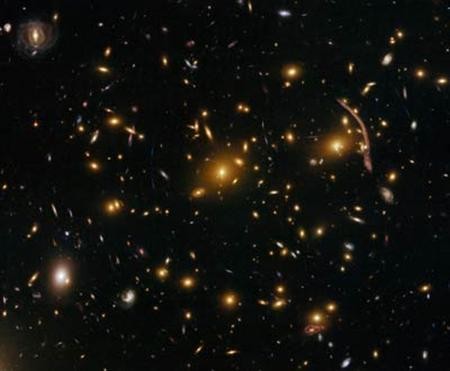NASA to Celebrate Hubble's 25th Year
| Marco Foronda | | Apr 04, 2015 09:39 AM EDT |
(Photo : REUTERS/NASA/ESA/HUBBLE SM4 ERO TEAM) Gravitational Lensing in Galaxy Cluster Abell 370 in an image taken by the freshly repaired Hubble Space Telescope and released by NASA.
April 24 will mark 25 years since NASA's Hubble Space Telescope (HST) was launched into orbit around the Earth.
Hubble has immensely helped the scientific community explore the solar system. It's also captured many mesmerizing picture of planets, stars a borning and other celestial objects.
Like Us on Facebook
It was April 24, 1990 when the Space Shuttle Discovery blasted off from Florida's Kennedy Space Center with a shiny bus-sized telescope inside its cargo bay. It headed farther out than any previous flight and deployed the Hubble Space Telescope to its 345 mile high orbit, where it remains to this day.
Astronomer Lyman Spitzer outlined the ideal telescope in 1946 and argued that from outside the atmosphere, a telescope's resolution would be limited only by its optics. A telescope in space could also see in infrared and ultraviolet light blocked from ground-based observatories by Earth's atmosphere.
The result was one of the greatest discovery machines of all time that pushes the limits of our knowledge and perception. While pictures are the public face of Hubble, more than 12,000 peer-reviewed papers have been published in scientific journals based on Hubble data, revolutionizing our understanding of the Universe.
The telescope helped in mapping the large-scale, three-dimensional distribution of dark matter, which neither absorbs light nor emits it. It also has a key role in the determination of the history of the cosmic star-formation rate.
Also, it released the Hubble Ultra-Deep Field, revealing 10,000 galaxies in an "empty" patch of sky the size of a grain of sand held at arm's length. This image helped consolidate popular support for one last HST servicing mission. It was the deepest, and possibly the most important exposure ever taken.
The Hubble has examined everything from the asteroids, comets, planets and moons of our solar system, to the stars and nebulae in our own galaxy and others. It has peered all the way across the Universe the near the beginning of time.
TagsNASA to Celebrate Hubble's 25th Year, NASA, Hubble Space Telescope, hubble, space exploration, Hubble Ultra-Deep Field, telescope
©2015 Chinatopix All rights reserved. Do not reproduce without permission
EDITOR'S PICKS
-

Did the Trump administration just announce plans for a trade war with ‘hostile’ China and Russia?
-

US Senate passes Taiwan travel bill slammed by China
-

As Yan Sihong’s family grieves, here are other Chinese students who went missing abroad. Some have never been found
-

Beijing blasts Western critics who ‘smear China’ with the term sharp power
-

China Envoy Seeks to Defuse Tensions With U.S. as a Trade War Brews
-

Singapore's Deputy PM Provides Bitcoin Vote of Confidence Amid China's Blanket Bans
-

China warns investors over risks in overseas virtual currency trading
-

Chinese government most trustworthy: survey
-

Kashima Antlers On Course For Back-To-Back Titles
MOST POPULAR
LATEST NEWS
Zhou Yongkang: China's Former Security Chief Sentenced to Life in Prison

China's former Chief of the Ministry of Public Security, Zhou Yongkang, has been given a life sentence after he was found guilty of abusing his office, bribery and deliberately ... Full Article
TRENDING STORY

China Pork Prices Expected to Stabilize As The Supplies Recover

Elephone P9000 Smartphone is now on Sale on Amazon India

There's a Big Chance Cliffhangers Won't Still Be Resolved When Grey's Anatomy Season 13 Returns

Supreme Court Ruled on Samsung vs Apple Dispute for Patent Infringement

Microsoft Surface Pro 5 Rumors and Release Date: What is the Latest?










